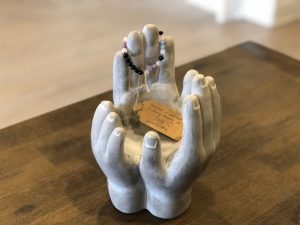A bracelet created by a WOMB client as a small token of
remembrance to honor pregnancy and infant loss.With nearly one in four pregnancies ending in miscarriage, one would think the knowledge and wisdom of this personal journey would be shared by generations of women while in reality, it is strikingly absent from conversations. Women tend to view this loss as a potentially dangerous medical event requiring a hospital visit. Let’s take a few minutes to shed light on the truth of pregnancy loss.
In reality, the vast majority of first trimester miscarriages remain uncomplicated and can happen in the comfort of your own home. Staying in your own space is not only more peaceful but it prevents the potential trauma or grief that might occur from a medically managed miscarriage. I hope the following can provide you with the information you need to put an end to your Google searching, settle into your body, and feel empowered on this difficult journey. We are here for you at any step along the way should you need or want to talk.
It is my hope that you find this resource both informative and empowering. Please share it with the women in your life so we can begin to shift the deeply held cultural views, increase the support, and begin normalizing conversations around pregnancy loss so that we can support each other through it. It is these conversations that will begin to heal centuries of fear and shame and allow a rich understanding of the complexity of being a woman.
— Dr.Pam
How Do I Know if I Am Having a Miscarriage?
Most miscarriages will hapen around the 6/7 week mark of a pregnancy, though it is possible up until 13 weeks. There are several signs that this may be happening:
- Vaginal spotting or bleeding
- A sudden decrease in pregnancy symptoms (nausea, breast tenderness etc)
- Low back ache
- Uterine cramping or contractions
If you are experiencing any of these symptoms, you can meet with your midwife or doctor to confirm on ultrasound that the baby has stopped growing or to check for a heartbeat. If you’re very early in the pregnancy, it might not be clear on ultrasound whether a fetus has formed, or whether it is still living. In this case, you may need further assessment to help put the question to rest. This might include transvaginal ultrasound, measuring blood levels of beta-hCG, and a repeated ultrasound at a near future date. It may also be necessary to rule out an ectopic pregnancy, a complication in which the fertilized egg implants and begins to grow in one of the fallopian tubes – which needs to be managed either with medications or sometimes surgery.
These are the tough “seeking answers” days but please remember that you have done nothing wrong and once a miscarriage has begun, there is nothing anyone or any search can do to stop it.
What Are My Options?
It is important to understand your 3 options for moving through this process. The first two options are “at home” and the third option requires a hospital visit. When possible, it is my preference that women have their miscarriages in the comfort of their own homes surrounded by the support of their partners or loved ones. The options include:
Watchful Waiting: Means exactly that. You stay at home, lay low and let nature run its course. This is the most natural way for a miscarriage to proceed but can take some time and challenge your patience. Though the waiting might feel unbearable, once the process gets going, it normally takes place within roughly 6 hours. Most miscarriages do not need intervention and can be managed this way. If the miscarriage doesn’t begin on its own within a few weeks, or you get tired of waiting, one of other options will be required. If at any time, heavy bleeding, persistent pain, or any signs of infection develop, then the 3rd option will be needed. Approximatley 90% of miscarriages that begin on their own, will resolve without treatment within a few weeks.
Misoprostol: This is a medication that is routinely used to bring on a miscarriage more quickly. It works by inducing uterine contractions that will push its contents out of the body. Misoprostol is used when a miscarriage is not complete and is not necessary under normal conditions. This medication can be taken orally or placed in the vagina. If you take them orally, please take them with food to avoid stomach upset, pain or diarrhea. Using these pills vaginally will avoid some of the gastrointestinal side effects, but requires that you lie down and not go to the bathroom for at least 30 minutes. After 30 minutes you are perfectly safe to get up and move around. If the pill falls out, it is okay, you have absorbed what you need.
I suggest that when taking misoprostol, you don’t do it when you are taking care of another child or that you really have anything else to do for the next several hours, including sleep! I prefer that you have someone comforting near you, and that you simultaneously take some pain medication and wear a night-time sanitary napkin. Though lots of women only experience mild cramping and bleeding, the cramping can catch you off guard with its intensity. The bleeding should begin within an hour and behave much like a regular albeit heavier and more painful period lasting 7-14 days and may be more clotty than you are used to. The clots might be surprisingly large depending on how far along you are. The cramping typically begins about one to two hours after the medication and should only last 5-6 hours although it may feel like an eternity. Because of this delay in the onset of bleeding and pain, I would advise you not to take this medication at bedtime or it will disrupt your sleep immensely. Please rest and honour your body as much as you can during these difficult hours.
You will have a follow up appointment with your care provider following the use of misoprostol to ensure it was effective and sometimes (though rarely), will require a repeat dose one week later.
Misoprostol will not affect your chances of getting pregnant again but it is suggested that you don’t have intercourse or put anything (tampon/douche) inside the vagina for at least two weeks following this treatment. Overall, misoprostol is a very safe at-home treatment option.
Surgical Options: Suction (uterine aspiration) or dilation and curettage (D&C)
These procedures are typically reserved for a last resort or used in cases of heavy bleeding or complications. Both procedures are done in the hospital, under anesthetic and involve dilation of the cervix. These procedures are invasive but 100% successful. The physical down-time is relatively minimal and the risk factors are largely associated with the anesthesia. These are the gold standard procedures when miscarriage is incomplete, medications don’t work, or there are complications during the process. Though many women have asked my why they don’t start here and “just get it over with”, please understand that the majority of miscarriages do not reqiure such invasive procedures and our hospital system is not, nor should it be designed for D&C on demand services. These options are reserved for emergent situations and speaking from personal experience, they are unpleasant and not something you wish to endure unless absolutely necessary.
Making Your Choice May Depend on the Type of Miscarriage You Are Having:
How you choose to handle your miscarriage experience is largely a personal decision, though it may be dictated by medical factors (heavy bleeding, for example) or what type of miscarriage you’re having, which is discussed below.
Miscarriage isn’t a one size fits all phenomenon – there are four main types, each of which influences how long a miscarriage might take to get started spontaneously, and how effective each strategy might be. Your midwife or doctor can usually tell you which type you’re having, based on an ultrasound, and this can help you decide which approach you’d prefer or is available to you.
Natural Miscarriage will typically happen early in the pregnancy when some women might not even know they are pregnant. Most of the time this will appear as a late and maybe a slightly more heavy period and the bleeding will not last more than 7 days. This type of miscarriage does not require any medical intervention and your cycles should resume as normal the next month.
Incomplete Miscarriage means that the process has begun on it’s own but is dragging on for several days or weeks. Though it is safe to wait this out under the supervision of your midwife or doctor, many women will opt to try misoprostol in these circumstances, which will complete the process within a week in about 90% of cases.
Fetal or Embryonic Demise means that the pregnancy has stopped developing on its own but is not passing. In about 75% of these cases, the pregnancy will pass on its own given enough time but many women will opt for medication at this point so as to not prolong the pregnancy any longer.
“Empty Sac” means that the pregnancy stopped before the fetus began to develop. Natural miscarriage is slightly less likely (approximatley 66%) in these cases and medications remain a good choice to get things going for you.
Regardless of the type of miscarriage, many women will begin with the waiting at home option. It is possible at any time to switch options so please reach out to your care provider at any time if needed.
What About That Pink Line? Home pregnancy tests are convenient and relatively inexpensive. They measure the level of hCG in your urine and when used correctly, are very accurate. HCG levels will begin to rise as early as 10 days after conception and continue to rise each day of the pregnancy peaking at about the 12th week. That little pink line is the first breathtaking indicator of pregnancy for almost all women. Though the tests are accurate and highly sensitive, they cannot tell you the state of flux in the hormones and will remain positive for many days. How long the strips still read hCG after a miscarriage will depend how far along you were in the pregnancy but the speed of change, or intensity of the pink line is not an accurate way to determine if you are still pregnant. Unfortunately you may still test positive for several weeks after a miscarriage. Your doctor or midwife can order two blood tests for hCG taken a couple of days apart to get an accurate picture of the changing hormones. Repeated home pregnancy testing can be a source of heartbreaking false hope so I encourage you to to put the box away and listen to your little inner voice or ask your care provider for blood testing.
Can I Go Through This At Home? Unless you are having surgery, you will go through this at home. Here are some of my favourite tools for making this experience as positive and healing as possible:
Rest: Optimally this experience will take place at home and NOT at work or anywhere else that you have to “show up” and be anything but nurturing to yourself. If possible I like women to take at least a couple of days off from their jobs or responsibilities.
Nest: Creating a healing “nest” in your home is a beautifully healing ritual. Cozy clothes, warm blankets, candles, a hot water bottle, movies, a great book and your favourite snacks can all soften this experience. Having a loved one or close friend nearby is a good idea for both emotional support, and to keep an eye on you in case any problems should arise.
Nourish yourself throughout with whole foods, teas, and lots of water. If you are taking medications, be sure to graze throughout the day to keep your energy up and your nausea down.
Comfort yourself and your body:
- Hot water bottles or warm compresses on your abdomen
- Gentle massage or a foot rub from a loved one can ease pain and distract from cramping
- Deep breathing and visualization of your uterus gently emptying can be a powerful tool.
- Warm baths and showers if water feels healing to you.
- Herbal teas like chamomile and lemon balm sipped throughout the experience
- Pain medication is both safe and effective taken according to the label.
Although you are uncomfortable both physically and emotionally, please remember that your body has a deep knowledge of how to do this and what it needs. Trust your body and follow your intuition. Feeling armed with knowledge of the process will ease this entire experience.
What Should A Miscarriage Feel Like?
If you are taking a watch and wait approach, your miscarriage symptoms may take several days (or even weeks) before it really begins and there may be cramping and spotting throughout this waiting period. Eventually, both the cramping and bleeding will intensify for several hours until the uterus empties itself. Sometimes the build is gradual and confusing and sometimes the gushes of blood and sudden intense cramping make the process very clear to you. For some women it is not much different than their regular monthly cycle. If you are taking misoprostol, the cramping will begin within 2-4 hours and last up to 6 hours and is unmistakable. Though this may all feel very unfamiliar to you, please remember your body knows exactly what it is doing.
What Should I Watch For or When Should I Seek Medical Care?
Though you have undoubtedly read or heard a miscarriage horror story, the vast majority of miscarriages are uncomplicated and resolve all on their own. Having said that, there are some minimal risks of infection or hemorrhage that should not be ignored. Please seek medical care should any of the following occur:
- You’re bleeding heavily enough to soak two maxi pads per hour for two hours in a row. This is more common after misoprostol but should be milder within about three hours. Heavy bleeding longer than 3-4 hours can be a cause for concern.
- You have a fever over 101°F (38.3° C) if you did a watchful waiting approach, or over 102°F (38.3° C) if you did a medication approach (a slight fever of 102°F or less is a common side-effect of misoprostol use).
- You start to feel very unwell at any time, or have lower abdominal pain after the cramping is done.
Self Care During Pregnancy Loss
Most of this resource guide has been focused on the physical nature of pregnancy loss. I believe it is at least equally important to draw awareness to the inner experience. When we allow time and create space around these uniquely female experiences, our hearts and minds will integrate them with less trauma and more inner peace. When we share our journey with our sisterhood – the women in our lives that we love and trust, we not only recruit help carrying our pain, but we open up a conversation about pregnancy loss that is desperately needing to be had by so many women. Some women will create a ritual around loss that may include a burial, a naming ceremony or letter writing. I recognize that this is a deeply personal experience and that women can feel lost in this. At The WOMB, we host a Healing Circle as a free drop-in, check-in and an opportunity to honour your loss. We also offer body work and counselling appointments designed specifically for women going through miscarriage that can help to regulate the nervous system and help the body release tension and emotion. If you are feeling lost and alone or feel like touching in with our team in this way would be helpful, give us a quick call, drop us an email, or just pop in. You are not alone!
When Is It Okay to Try Again?
This is one of the most common questions I receive and the answer is quite simple – as soon as you feel ready. There is no medical reason to wait a few cycles and in fact research indicates that for some reason, your fertility is enhanced in the month after miscarriage. I like women to begin taking (if they haven’t already) a good prenatal vitamin that contains methylated folic acid or at the very least, a methylfolate on its own. It is possible that your iron is quite low so if this is something that you are at all prone to, it is advised to take a little iron for at least a few weeks. Nourishing teas like nettle, oatstraw, alfalfa or red raspberry leaf are helpful to restore balance and replace nutrients. Please be assured that having a miscarriage does not affect your future fertility and now that you are through it, all is well.

Dr. Pamela Thornton is a Naturopathic Doctor at The WOMB Woodstock. Pamela is an integrative practitioner and passionate leader in the field of women’s hormonal health issues and fertility.
If you need help, have questions or need someone to talk to please call us or email the location closest to you.






